Jet lag a thing of the distant past, we’ve been back here at Greenroofs.com for a few weeks after our extremely interesting and entertaining trip to the UK capitol and the 2008 World Green Roof Congress (WGRC). Many of our readers expressed a lot of advance interest in attending this particular conference because of the location and their opportunity to do additional sightseeing in the beautiful English countryside and beyond. In fact, most of our fellow participants did just that, adding vacation days to their trip across the pond to take full advantage of their stay.
Due to time constraints, we opted to arrive the morning of the first day of the Congress on Wednesday September 17 figuring (wrongly) we’d get there in plenty of time. Manuevering from Gatwick to our hotel was quite a workout with bags in tow (not to mention horrifically expensive at about $130 for two, round trip) – and I can honestly say that Grand Central Station in New York doesn’t even come close to the hustle and bustle of Victoria Station! “Move It or Lose It” should be their motto.
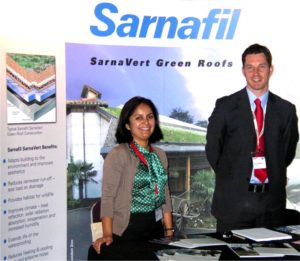 We hadn’t seen Dusty Gedge of Livingroofs.org in a few years, and he welcomed us warmly and enthusiastically – in fact, both Aramis and I felt right at home among seasoned colleagues and new friends, too. In particular, Paul Shaffer and Nipa Patel of CIRIA were just wonderful. I’ve e-worked with Paul before, having reviewed the successful “BUILDING GREENer – Guidance on the use of green roofs, green walls and complementary features on buildings (C644),” (by Paul Early, Dusty Gedge, John Newton, and Steve Wilson, 2007 from CIRIA,) but meeting Nipa and Paul was very special – they’re really good people with not only great patience and organizational skills, but a great sense of humor, too. All characteristics which must come in handy while planning an international conference of this stature.
We hadn’t seen Dusty Gedge of Livingroofs.org in a few years, and he welcomed us warmly and enthusiastically – in fact, both Aramis and I felt right at home among seasoned colleagues and new friends, too. In particular, Paul Shaffer and Nipa Patel of CIRIA were just wonderful. I’ve e-worked with Paul before, having reviewed the successful “BUILDING GREENer – Guidance on the use of green roofs, green walls and complementary features on buildings (C644),” (by Paul Early, Dusty Gedge, John Newton, and Steve Wilson, 2007 from CIRIA,) but meeting Nipa and Paul was very special – they’re really good people with not only great patience and organizational skills, but a great sense of humor, too. All characteristics which must come in handy while planning an international conference of this stature.
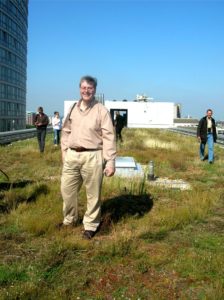 Delayed bags made us unfortunately miss the better portion of the Wednesday morning session: Jim McLelland, Editor of sustain’ magazine (and the Congress Media Partner), opened the Congress with the Chairman’s Introduction followed by the Keynote Address from Richard Blakeway, Advisor to the Mayor of London on environment issues. The London Plan addresses sustainability from many aspects and incorporates green roofs and green walls. London climate change partnerships were discussed along with achievements and plans for the future. The North American and German perspectives were tackled by Peter Lowitt of Green Roofs for Healthy Cities and Wolfgang Ansel of the International Green Roof Association (IGRA), respectively, addressing the drivers for implementing greenroofs, the benefits and achievements of their approach, challenges faced and lessons learned, ending with future plans.
Delayed bags made us unfortunately miss the better portion of the Wednesday morning session: Jim McLelland, Editor of sustain’ magazine (and the Congress Media Partner), opened the Congress with the Chairman’s Introduction followed by the Keynote Address from Richard Blakeway, Advisor to the Mayor of London on environment issues. The London Plan addresses sustainability from many aspects and incorporates green roofs and green walls. London climate change partnerships were discussed along with achievements and plans for the future. The North American and German perspectives were tackled by Peter Lowitt of Green Roofs for Healthy Cities and Wolfgang Ansel of the International Green Roof Association (IGRA), respectively, addressing the drivers for implementing greenroofs, the benefits and achievements of their approach, challenges faced and lessons learned, ending with future plans.
Speaking of the International Green Roof Association, make plans now to attend the International Green Roof Congress 2009 in Nuertingen, Germany on May 25-27, 2009. Under the patronage of the German Federal Minister of Transport, Building and Urban Affairs, the congress will be hosted by IGRA and the Deutscher Dachgärtner Verband e.V. (DDV). Wolfgang is extremely excited about the program which will include the latest technological developments within our industry as well as detailed case studies of spectacular greenroof projects from renown international architects and designers. Of course, there will be hands-on workshops and excursions to Stuttgart and Freiburg, too.
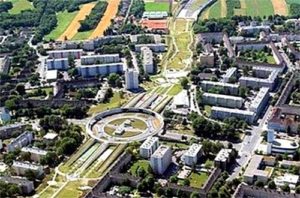 Edmund Maurer from Linz, Austria, gave “Green Roofs in Linz – A European municipality perspective on green roofs” including the history and development of the Linz Green Roof Policy, incentives, rationale, and barriers to implementation. The City of Linz uses a combination of legal framework, financial grants, and policy incentives. In 1985 legally binding development plans required greeenroofs, either extensive or intensive and a green roof subsidy was implemented in 1989, marking the first direct financial incentive in Austria. At present, Linz has approximately 440 funded greenroofs with a total greened of about 500,000 m2 (5,381,955 sf), which includes the Bindermichl Landscape Park at 81,000 m2, designed with playgrounds above a motorway tunnel.
Edmund Maurer from Linz, Austria, gave “Green Roofs in Linz – A European municipality perspective on green roofs” including the history and development of the Linz Green Roof Policy, incentives, rationale, and barriers to implementation. The City of Linz uses a combination of legal framework, financial grants, and policy incentives. In 1985 legally binding development plans required greeenroofs, either extensive or intensive and a green roof subsidy was implemented in 1989, marking the first direct financial incentive in Austria. At present, Linz has approximately 440 funded greenroofs with a total greened of about 500,000 m2 (5,381,955 sf), which includes the Bindermichl Landscape Park at 81,000 m2, designed with playgrounds above a motorway tunnel.
Paul Collins, Head of Design Environment at Nottingham Trent University followed with his presentation of “Green roofs: British policy responses and practice.” It was nice to finally meet Paul later, too, as we had been corresponding for many years.
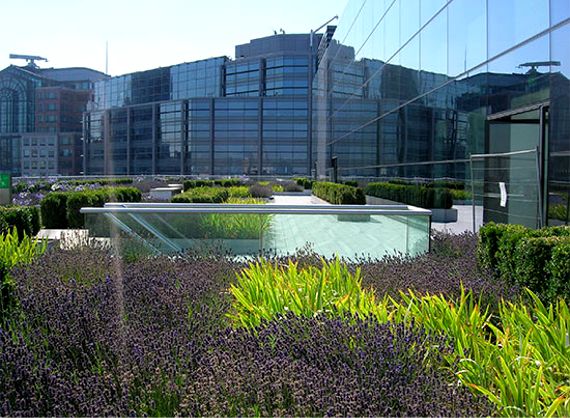
We arrived at the beautiful glass structure of One Bishops Square in Spitalfields, home to the London offices of Allen & Overy, the WGRC host, close to noon and joined the other 300 attendees in time to hear Duncan Young of Lend Lease, UK talk about “Commercial drivers for green roofs” which was very heartening. He talked about some of the amazing projects that Lend Lease is currently working on, both in the UK and Australia. Lots of green buildings and greenroofs! For example, one of the UK’s largest regeneration schemes is Greenwich Peninsula which is being developed by a joint venture between Lend Lease and Quintain, working with English Partnerships. Over the next 15 years, the £5 billion regeneration of Greenwich Peninsula will be transformed into a thriving riverside community with about 20,000 residents and 24,000 workers. Upon completion, at 190 acres this extensive new quarter of London is expected to form Europe’s largest mass of greenroofs. And we were told that approximately 70% of the 2012 London Olympic Games structures will be greenroofed!
Update of July, 2011: 70% was a bit optimistic back in 2008, but there will be greenroofs. For example, to meet green building regulations, the International Broadcast Center will incorporate a ‘brown roof’ and recycling non-drinking water (via About.com). Of course, a brown roof is very similar to a greenroof, but it more greatly encourages the creation of biodiversity because of the high rubble/mineral substrate and wide, open sparsely planted roof. The gravel, moss, and other low nutrient plant life will encourage insects, invertebrates and habitats for the reported 100 bird and bat boxes to be incorporated on site.
The morning Question and Answer session followed with many people asking about insurance issues, especially as recently raised by Swiss insurance giant Zurich Re – see the related article in Building.co.uk “Insurers warn of fire risk from green roofs” by Michael Willoughby of September 5, 2008. People discussed how non-vegetated fire breaks are critical as well as setting a maintenance regime and having supplemental water available. In terms of leaks, respondents said that just like in all of the roofing world, flat roofs, greened or not, are the problem. And it was brought up that many European insurance giants actually have greenroofs on their own buildings, including Munich Re! Austrian Edmund Maurer added that his country in general has problems related to greenroof maintenance, and several German delegates agreed that this issue was present in their homeland as well. Also, with the current financial crisis in London (and elsewhere), it was asked how important is it to have incentives from government to promote further greenroof development. As important as it is to have local and national governments behind the promotion of greenroofs, many people responded that we really need to focus on greenroofs as amenity driven, not policy driven. Dusty said that after climate change, biodiversity is a major concern in the UK and that living roofs provide solutions for both.
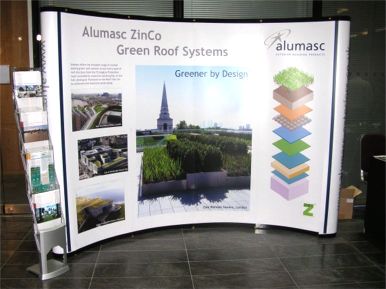
Next we enjoyed our lunch, and I have to say that overall the catering and service was excellent, which can be rare for these types of events. The exhibitor booths were arranged very smartly, in a U-shaped embrace of sorts around the central hall and all refreshments, lunches and snacks were set on tables within the exhibitor rooms to make it very easy to flow through, visit and network with other attendees and the greenroof trade show participants.
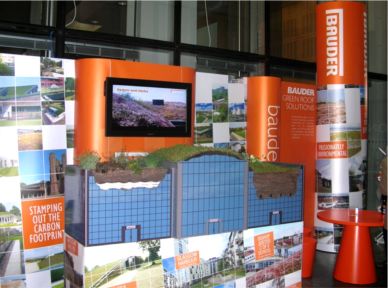
The afternoon session was also lively and we heard from some real leaders and mavericks in the field of architecture and research. Known for his design of visionary green “bioclimatic” skyscrapers, Dr. Ken Yeang of Llewelyn Davies Yeang offered “Designing for ecological sustainability” which talked about his philosophy of “mound to ground” and the need to connect greenroofs to the ground level through a series of corridors and fingers utilizing living walls and “landscaped skycourts.” He showed innovative designs from Hong Kong, New Delhi, Istanbul, Macao and Singapore. Dr. Yeang also stressed the importance of bio integration of the physical, systemic and temporal nature of each site, and that each project needs to be program-specific.
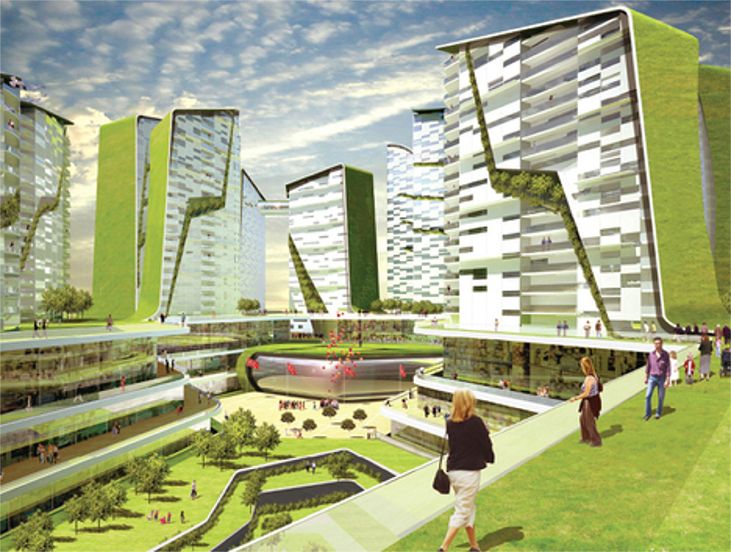
Another colleague of ours, Dr. Stephan Brenneisen of the University of Applied Sciences in Basel, followed with “Benefits for biodiversity” and the Swiss approach for creating higher biodiversity and cost effective greenroofs. Stephan said the low biotic diversity of many greenroofs is due to a very thin substrate layer, and using different types of local substrates and varying the depths ( 5, 8, and 12 cm, for example) creates various types of environments where a variety of flora and fauna may thrive. Referring to the growing media mix, he added that the greater the water storing capacity, the more biomass you’ll get on your roof which in turn creates greater opportunities for higher diversity. He also presented case studies including the Basel Exhibition Centre; Klinikum 2, Cantonal Hospital of Basel and the new Monument Development in London, which features the greenroof as a combination of art, design, and nature conservation.
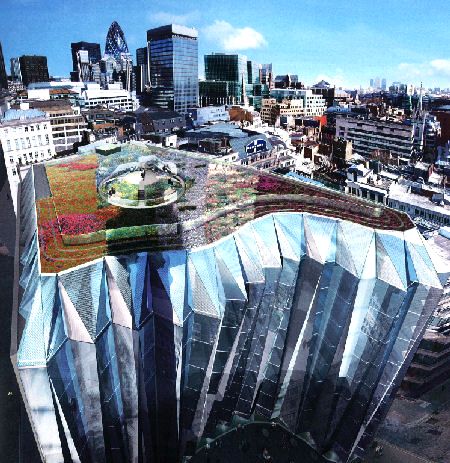
Our German friend Dr. Manfred Kohler from the University of Applied Sciences in Neubrandenburg and the President of the World Green Roof Network (WGRIN), spoke about “Benefits for sustainable water management” and how it is possible to design zero runoff properties. Greenroofs were discussed in relation to decentralized rainwater management with examples of research studies in Berlin. Manfred also informed us that at present, the 2008 FLL Proceedings are being finished.
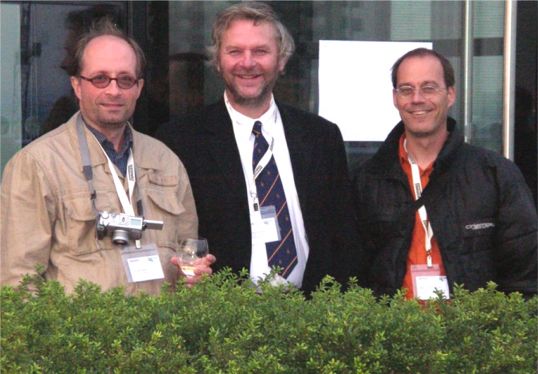
David Sailor from Portland State University presented “Energy and urban climate benefits of green roofs,” which could have been a boring, dry subject if that’s not your thing, but it wasn’t! A very likable fellow, Dave talked about the solar radiation properties of greenroofs – they reflect 20% – and the thermal variances between winter and summer. For example, a greenroof is 10 degrees C cooler in the summer, which is pretty standard, although a greater than 30 degree C heat flux is possible. Unfortunately, greenroofs can be warmer at night since they retain some of the day’s heat, but overall greenroofs reduce summer roof temperatures by 10 -30 degrees C. He gave examples of various energy studies including monitoring from ACROS in 1995 and the City of Portland, Oregon. Dave told us the DOE EnergyPlus 2007 modeling software incorporated his greenroof module which includes details of greenroof energy balance (see “A green roof model for building energy simulation programs” published in Energy and Buildings).
Dr. Nigel Dunnett of Sheffield University and The Green Roof Centre talked about “Landscape and Amenity: a UK Perspective.” Nigel suggested we “liberate design opportunities in the UK horticultural tradition” and wants us designers to be more liberal overall, utilizing both native and non-native plant species to create dramatic visual impact. His point was that we can design a living roof to be functional and attractive, and in fact the very important attribute of aesthetics will help promote the market. The Sharrow School in Sheffield was highlighted as a case study, with greenroofs at three levels. Modelled on the distinctive urban habitats of the region, its 8,000 m2 rooftop is a wildlife habitat of mounds and valleys with areas of: a small wetland, an open brownfield / rubble section, birch forest, limestone grassland, wildflower meadow and a colorful annual meadow.
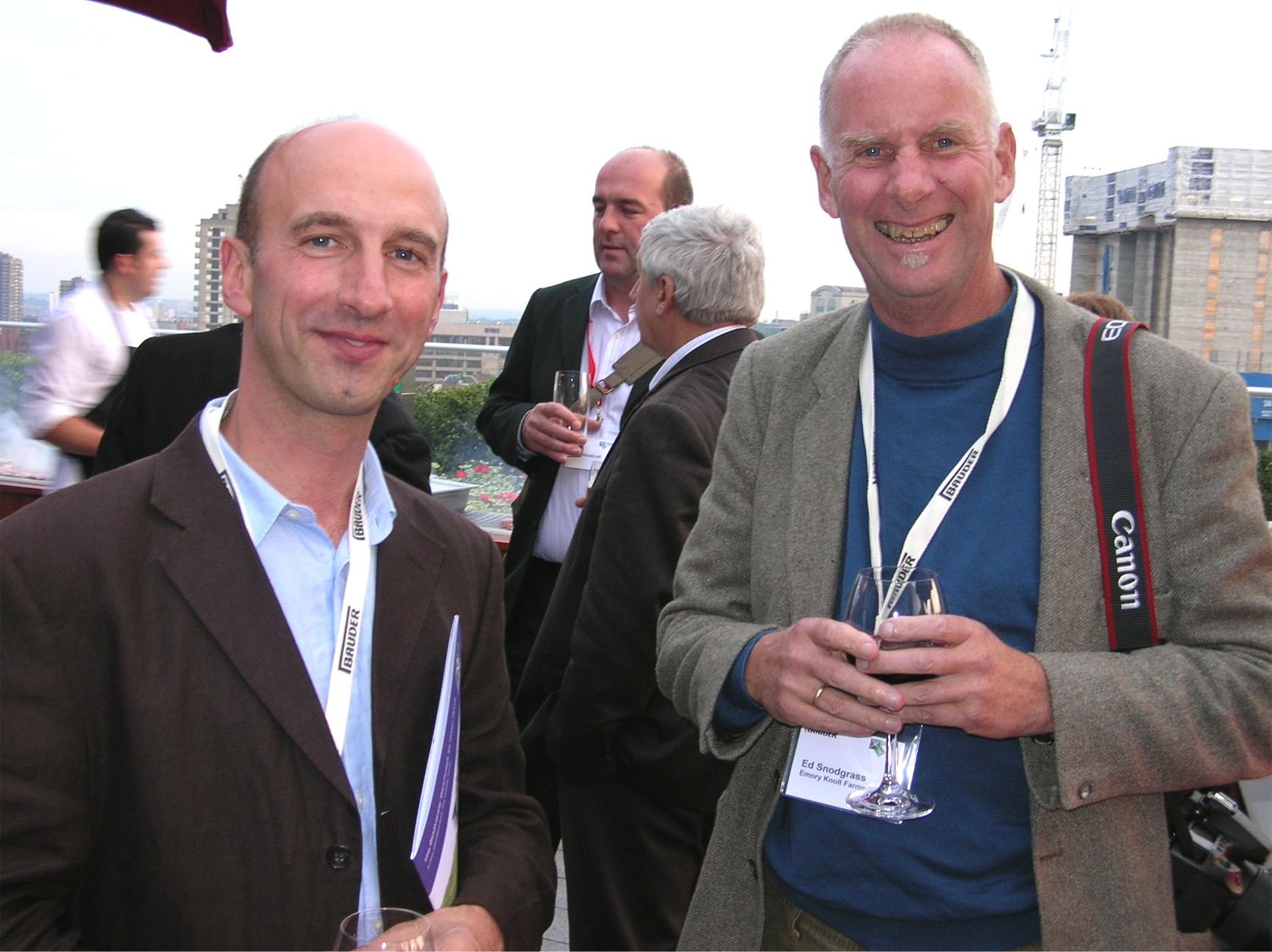
Closing the afternoon session was Robert Runcie of Environment Agency from England and Wales – he presented “Partnership approach to implementing green roofs.” Robert asked, “How do we use development as a stimulus?” Environment Agency is a national body working with colleagues in government and industry with the capacity to roll this as a best practice policy out across England and Wales. Over the past two years, they helped ensure that eight hectares of greenroofs were included in London. As part of their Green Roof Toolkit, they recently launched “Environment Agency’s Building a better environment: A guide for developers – Environment Agency advice on adding value to your site,” a web-based resource for developers and planners for the Thames Region.
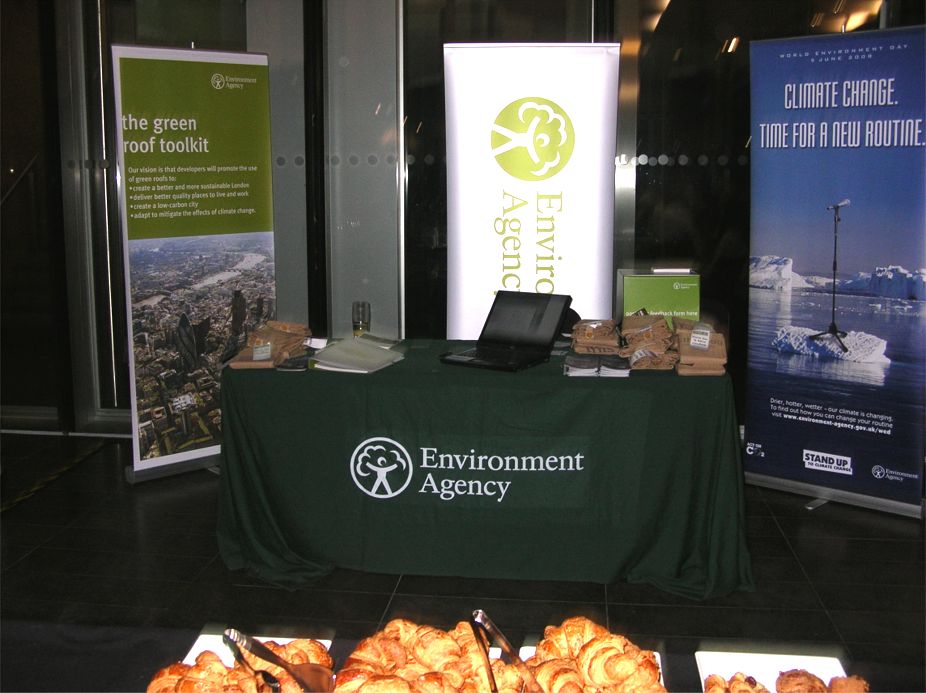
The pursuant Q & A session caused quite a stir and some people were dubbed “Native Plant Nazis” putting forth the classic argument of how we should be only using native plant species on our greenroofs. Basically the questions asked were Are aesthetics important enough for us to give up the biodiversity benefits that using native plants offer? Is it really necessary to use introduced species just for the wow factor? Many people responded that actually both natives and non-natives provide a multitude of benefits to wildlife, including valuable habitat, food and cover, and a variety of plants can be used for seasonal color and interest. A little tolerance, people! Don’t get me started – I’d like to write much more about this topic, so look for it later.
 After the close of this first day of the WGRC, the Congress Reception was held on the beautiful 10th floor intensive greenroof terrace of Congress Supporter Allen & Overy where we were treated to a lavish selection of tasty barbecue and lovely local UK wines and later, innovative lemon and chocolate mousse dessert shots.
After the close of this first day of the WGRC, the Congress Reception was held on the beautiful 10th floor intensive greenroof terrace of Congress Supporter Allen & Overy where we were treated to a lavish selection of tasty barbecue and lovely local UK wines and later, innovative lemon and chocolate mousse dessert shots.
The area encompasses three landscaped greenroof terraces, and a fourth terrace is covered with photovoltaic cells. The terrace layout offered intimate areas for reconnecting with far flung associates and social networking – who’s doing what and where, and what a view! The ever expanding London skyline was beautiful in the rosy hues of dusk.
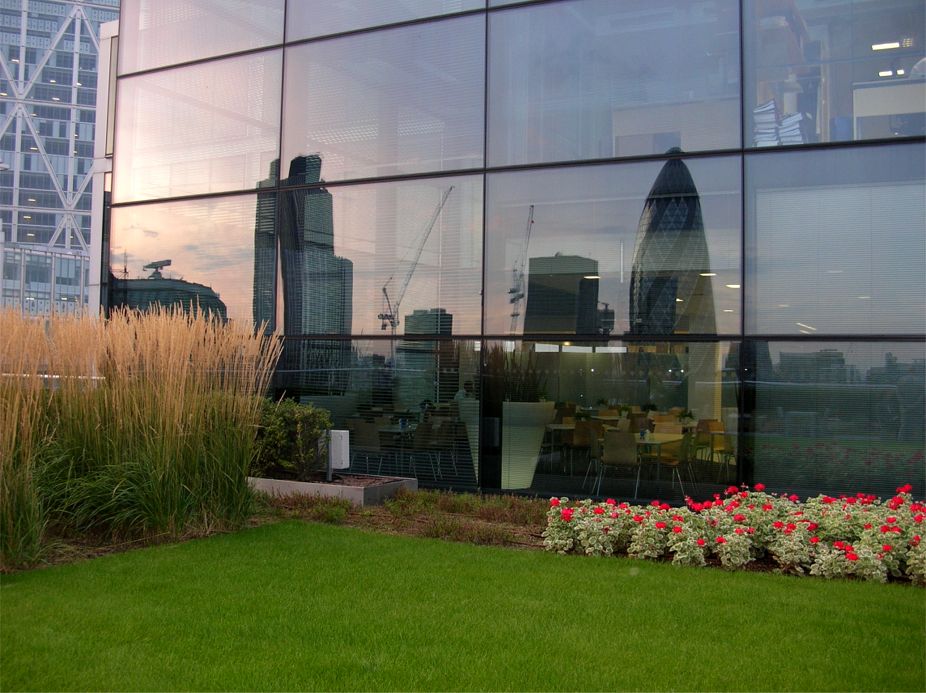
At the end of the evening we heard from Congress Sponsor The Wildlife Trusts who introduced their Biodiversity Benchmark for Green Roofs. The Biodiversity Benchmark for Green Roofs was created to support the increased development of living roofs in the UK and is the first standard to encourage excellence in design, implementation and management of green roofs for the benefit of wildlife. It was set up to support the UK Biodiversity Action Plan (BAP) to help increase the contribution that businesses can make towards enhancing biodiversity, and guidance materials provide advice on how to integrate biodiversity with environmental management processes.
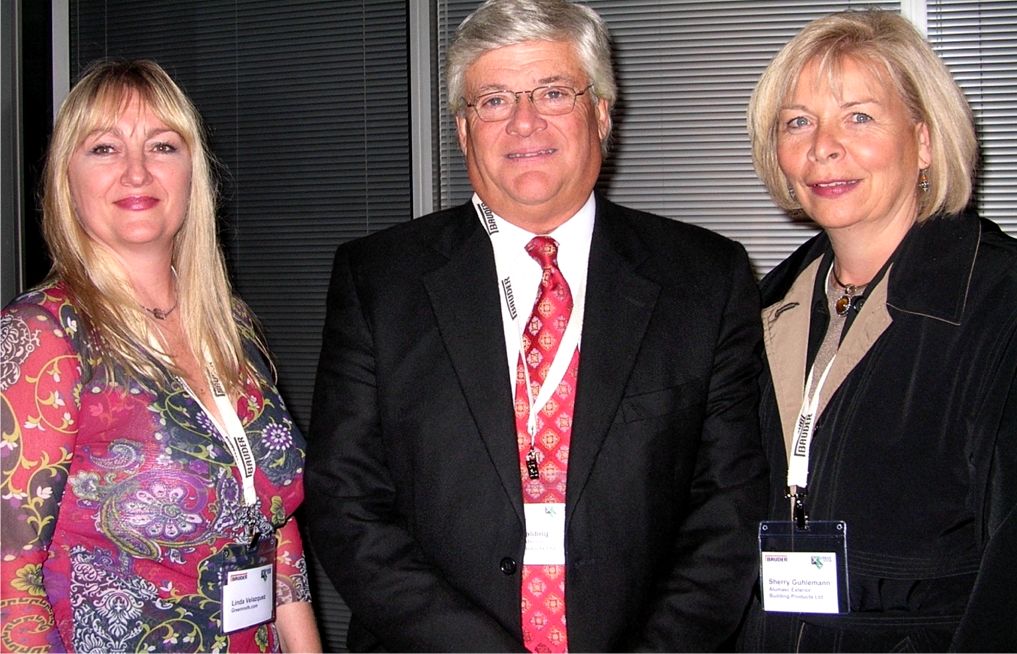
It was great just hanging out with friends who share the same passion as we do in a relaxing greenspace in a wonderful city. Stay tuned for a little more about the 2008 World Green Roof Congress and beyond when I’ll talk a bit about Day 2 and then our whirlwind London greenroof tour with Dusty and about 25 of his visiting colleagues!
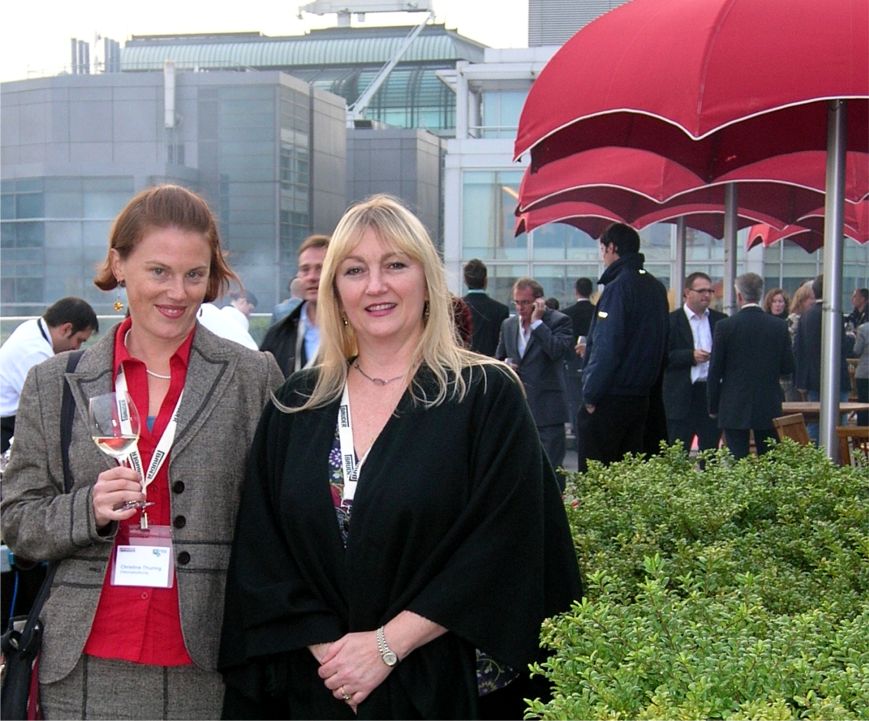
~ Linda
 Greenroofs.comConnecting the Planet + Living Architecture
Greenroofs.comConnecting the Planet + Living Architecture

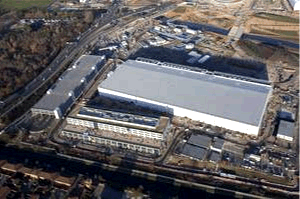



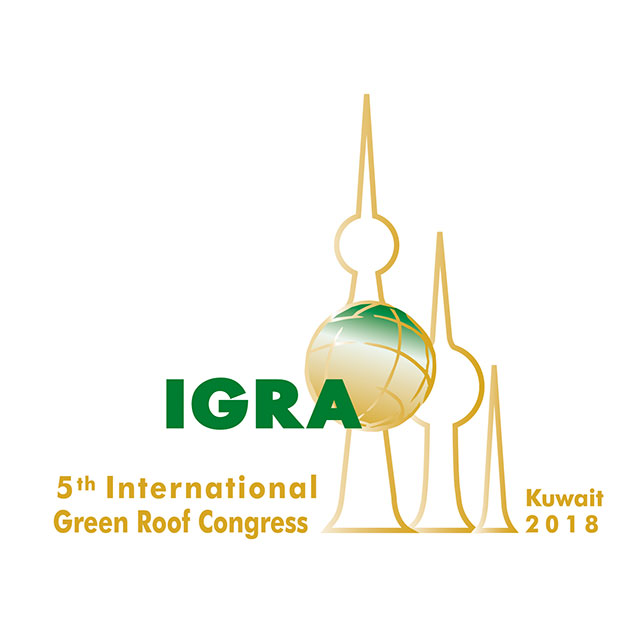




Jim Turner
what a great way to create usable green space. Kudos to people willing to take on this type of project!
mathew frith
linda, looked like you had a good time. sorry not to have bumped into you, but i’ve been far too busy here that i was unable to attend the congress – despite it being only a couple of km away. i’m glad it went swimmingly; and look forward to your tales of the second day.
regards,
mathew
Steven Peck
Congrats to Dusty for pulling this off and to you Linda for keeping us all in touch all over the world. Sorry I couldn’t make it this year. It looks like you had a blast.
Hope to see you all at Cities Alive in Toronto – October 19-22, 2009. Cheers SWP
Sky Gardens » Blog Archive » Spring Conferences: Stuttgart-Nürtingen and Atlanta Greenroofs, Here We Come!
[…] Ansel, the Coordinator, met up with us at last September’s World Green Roof Congress in London, and brought us up to speed with the upcoming Congress and their amazing line-up of […]
Sky Gardens » Blog Archive » World Green Roof Congress 2010 Abstract Submissions Due on Friday
[…] World Green Roof Congress is hosted and delivered by CIRIA and Livingroofs.org. We were there in 2008and had a grand time in a wonderful setting with many knowledgeable speakers! The Congress […]
Sky Gardens » Blog Archive » GPW: Allen & Overy LLP HQ, Bishops Square
[…] In fact, the prestigious offices of Allen & Overy has hosted both the 2010 and 2008 World Green Roof Congresses.  Aramis and I were lucky to have attended the 2008 World Green Roof Congress here put on by of Livingroofs.org and CIRIA, with support from the European Federation of Green Buildings, so we can attest to the beauty of the spaces and the hospitality of the greenspace; the views were pretty spectacular, too!  You can read a little about it here. […]
Sky Gardens » Blog Archive » Greenroofs & Walls of the Worldâ„¢ Virtual Summit 2011 Episode 25: Biodiversity and Greenroofs Panel Presentation
[…] CIRIA in partnership with Livingroofs.org, which I blogged about in my November 10, 2008 “An Awesome World Green Roof Congress in London! Day 1” (unfortunately, I never got around to blogging about the second day nor the awesome […]